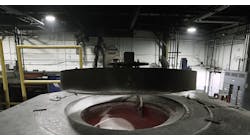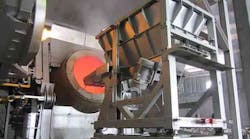The coreless induction furnace is essentially a refractory-lined vessel surrounded by an electrically energized, current-carrying, water-cooled copper coil. Electrical current in the coil forms an electromagnetic field, generating thermal energy that melts the charge. The magnetic currents in the molten metal cause an intense stirring action, thus ensuring a homogenous liquid mass.
In all coreless induction furnaces, there is an “ideal” refractory wall thickness, carefully calculated by the manufacturers to offer the optimum melting performance. Designed into this calculation are safety considerations, electrical characteristics of the coil, metallic charge electrical conductivity, structural and refractory considerations, operational constraints and production needs. When the furnace melt diameter is reduced by buildup, the melting process becomes compromised. Traditionally, to remove the buildup, furnace operators must mechanically scrape the lining that may also damage the refractory face. During this process, the power is generally reduced for safety reasons. The result is a reduction in the percent power utilization that causes the energy consumption to increase, which is graphically shown below:
Slag formation is inevitable during melting. In a coreless induction furnace, slag residuals normally deposit along the refractory walls and within the active power coil. The composition of slag varies with the type of metal being melted in a coreless furnace. The cleanliness of the metallic charge, (consisting of sand-encrusted gates and risers, or rust- and dirt-encrusted scrap) significantly affects the type of slag formed during the melting operation. Because these oxides and nonmetallics are not soluble in the molten metal, they float in the liquid metal as an emulsion. This emulsion of slag particles remains stable if the molten metal is continuously agitated, the result of the magnetic stirring inherent in coreless induction melting. Until the particle size of the nonmetallic increases to the point where buoyancy effects countervail the stirring action, the particle will remain suspended. When flotation effects become great enough, nonmetallics rise to the surface of the molten metal and agglomerate as a slag. Once the nonmetallics coalesce into a floating mass on the liquid metal they can be removed. The use of fluxes accelerates these processes.
When slag makes contact with the hot face of the refractory wall that is colder than the melting point of the slag, the cooling slag will adhere to the lining. This adhering material is called buildup. High-melting point slags are especially prone to promoting buildup. If not prevented from forming or not removed as it forms, buildup will reduce the overall efficiency.
Controlling buildup allows for continuous furnace operation. Buildup can be controlled or eliminated with the addition of fluxes. It should be noted that in the past ferrous foundries have been discouraged from using fluxes by refractory companies. However, new developments in flux chemistry (Redux U.S. Patent 7,68,473) allow fluxes to be used in furnaces lined with even silica refractories, without refractory attack. Generally, adding fluxes ensures that slags have a melting point below the coldest temperature in the system. Fluxes can help prevent slags and other insolubles from freezing on the cooler refractory surfaces. Using a flux allows for the flotation of the emulsified oxides; it also reduces the melting point of the slag to below the lowest temperature encountered in the melting furnace and associated liquid metal handling system.
Improper use of fluxes can rapidly erode refractory furnace linings, especially if potent fluorspar-based fluxes are used. However, if a flux is carefully engineered for specific applications and used properly, refractory life may actually increase. Some foundries using specialty fluxes have reported increased refractory life. One large foundry significantly increased lining life from 11 months to 26 months just by incorporating Redux in their operation. Refractory life also can be extended by reduced damage due to mechanical chipping required to remove tenacious slag deposits. Elimination of buildup optimizes power utilization, thereby reducing energy consumption.
Foundry G is a medium-sized manufacturer of gray iron castings. It has historically experienced extensive slag buildup on the upper sidewalls of its four 3-ton medium-frequency coreless induction furnaces in a semi-batch melting operation. Foundry G’s charge consists of 100% metallic fines. Each coreless furnace is lined with a silica dry vibratable refractory. During melting, slag generation and accompanying buildup immediately reduced furnace capacity and contributed to increased power consumption. After 48 hours of operation, three inches of buildup occurred along the entire sidewall. Foundry G initially incorporated 2 lb of Redux EF40L flux per ton of charge, added to each back-charge to determine its effect on buildup. EF40L was placed in the furnace before back charging on top of existing molten metal to ensure excellent mixing (a minimum 50% molten metal bath). Immediate improvements were observed and buildup along the sidewalls was essentially eliminated. Foundry G observed the following benefits by using Redux on a continuous basis:
- Using Redux EF40 reduced “bridging” tendencies due to cleaner refractory walls
- Reduced power consumption during each melt
- Hourly maintenance from scraping was greatly reduced
- Consistent furnace capacities, with less interruption for charging delays
- Improved “electrical coupling” was observed with improved temperature control
- No adverse effects on the dry vibratable silica refractory linings.
Foundry D operates two, 12-metric ton, 9,000-kW, 180-Hz medium frequency coreless furnaces batch melting ductile-base iron. Each 12-metric ton charge consists of 15% ductile pig iron, followed by the addition of 35% carbon steel clips and 50% ductile returns. Tap temperatures average 2,775oF. Current batch melt time (from charging to completely molten) is typically 40-50 minutes per heat. The furnace is lined with a dry-vibratable silica lining. Without fluxing, buildup would occur along the sidewalls of the furnace, including in the active power coil. This caused delays in charging, reduced furnace capacity, and longer downtime for scraping the lining, adding an additional 5 to 15 minutes per heat. Buildup above the molten metal line (top cap area) caused additional production delays. By adding 6 lbs of Redux EF40 flux with each charge, slag buildup is eliminated. Refractory lining life increased from 4,500 tons throughput to 7,500 tons per lining installation. Foundry D continues to realize the following benefits from fluxing:
- Furnace volume remains constant at 12 metric tons
- Consistent melting cycles of 40-50 minutes for each charge
- Less frequent top cap cleaning
- Delays at the mold line for molten iron was reduced by 50%
- Reduced mechanical damage to the refractory by eliminating scraping.
Insoluble buildup and slag related problems have become serious issues for foundries. These problems will likely increase as the quality of scrap continues to deteriorate. Using fluxes properly can alleviate these challenges while increasing melting efficiency and saving foundries time and electricity, and most important, improving profitability.
D. C. Williams is v.p. - Technology and R. L. (Rod) Naro is president and CEO of ASI International Ltd. William Duca is president of Duca Manufacturing.









